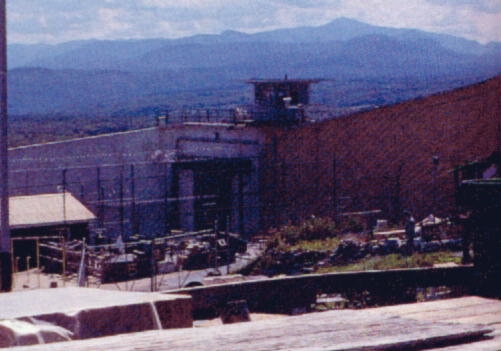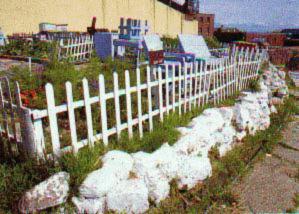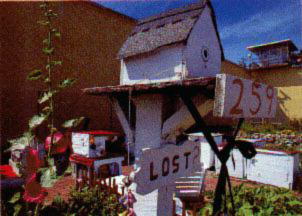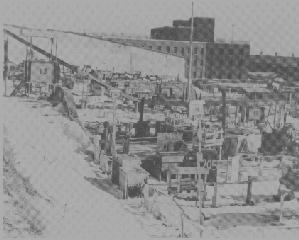
This picture (above) overlooks the "courts" in the north yard of the prison in Dannemora, looking south to Whiteface Mt.





The "courts" of Clinton Prison's North Yard are
individual areas used by inmates during recreational periods. I took a tour
of the prison in the late 1950's and this was a very interesting part of
the tour. At different times there was a ski jump (visible in picture
below) here and even a bobsled run. I remember "Hobo Jungle" used to
describe this area as well as "Shanty Town", which was probably a carry over
from the "Shanty" pictured on Page 1.
 For Decades untold the vast north yard of Clinton Correctional Facility,
in Dannemora has been covered with what appears to he a shantytown full
of handmade wooden fences and furniture, cookstoves, paths and gardens.
In fact the dozens of small plots, known as "courts," are places where groups
of inmates are allowed a measure of freedom to plant flowers or vegetables,
sculpt the stony earth into terraces, and even cook beans and rice or pasta
purchased at the commissary. From these courts the incarcerated men can look
out across the sloping grounds of the prison, over the roofs and guard towers
of the vast south wall and beyond to the Adirondack High Peaks. Most prisoners
have never been to the mountains and have no desire to go. About seventy percent
of our inmates come from New York City," reports superintendent Daniel Senkowski,
"and and most are serving very lengthy sentences."
For Decades untold the vast north yard of Clinton Correctional Facility,
in Dannemora has been covered with what appears to he a shantytown full
of handmade wooden fences and furniture, cookstoves, paths and gardens.
In fact the dozens of small plots, known as "courts," are places where groups
of inmates are allowed a measure of freedom to plant flowers or vegetables,
sculpt the stony earth into terraces, and even cook beans and rice or pasta
purchased at the commissary. From these courts the incarcerated men can look
out across the sloping grounds of the prison, over the roofs and guard towers
of the vast south wall and beyond to the Adirondack High Peaks. Most prisoners
have never been to the mountains and have no desire to go. About seventy percent
of our inmates come from New York City," reports superintendent Daniel Senkowski,
"and and most are serving very lengthy sentences."
Adirondack Life NOVEMBER/DECEMBER 1997
The following is a note I received in Dec 1997 that prompted my jumping
ahead in my article:
My name is Ron Roizen. Twenty-five years ago last
September I paid a visit to Clinton on behalf of a team of prison architects.
I was invited there to examine one of the Dannemora' facility's most unlikely
features. Out in the prison yard on a gently sloping hillside was a collection
of inmate-maintained patios--that everybody called "The Courts." The site
looked just a little ramshackle and certainly not like anything that belonged
in a U.S. correctional institution.
Inmate groups maintained each "court." Each had
a modicum of furniture and perhaps a couple of 55-gallon drums serving as
campstove and refigerator, the latter buried to keep in the cold. Patios
also had small flower and vegetable gardens as well as, astonishingly, modest
supplies of cutlery and other necessary utensils for cooking and eating.
My job was to try to piece together the history
and understand the relationship of this extraordinary institution. I spent
a week roaming around the courts talking to inmates, guards, and staff--especially
seeking old-timers. I also ransacked the Dannemora town library for info
and even did a little schmoozing in the local bar, across the street from
the prison's high wall, trying to find out as much as I could.
It was a fascinating expedition. In the end I
wrote a 55-page report on what I had managed to find out--only scratching
the surface of the court's story to be sure, but nevertheless a start. Some
extracts from my report, and a number of rich photographs of the courts were
published in *Architectural Record* a year or two later.
And then...25 years passed by and I never heard
another word about them. I don't know if they still exist; if they do, I
don't know how they've changed--for better or worse. But I DO know that an
update on them would be fascinating, particularly so because a 25-year-old
narrative and photographic record of them still exists--along with my vivid
memories. It is a hidden anomaly and an outstanding example of how--even
within the rigid framework of a maximum security prison--innovation and diversity
can take root and flourish.
BACK to page 1 BACK To page 2.
Sources:
Adirondack Museum photos, Blue Mountain Lake, NY;
Hurd, History of Clinton County, New York;
Anne Mackinnon, Welcome to Siberia, Adirondack Life, Nov/Dec 1997.
Gilroy, The Village People of Dannemora, and photos;
Dunot pictures on line:
 rodbigelow@netzero.net
rodbigelow@netzero.net 
